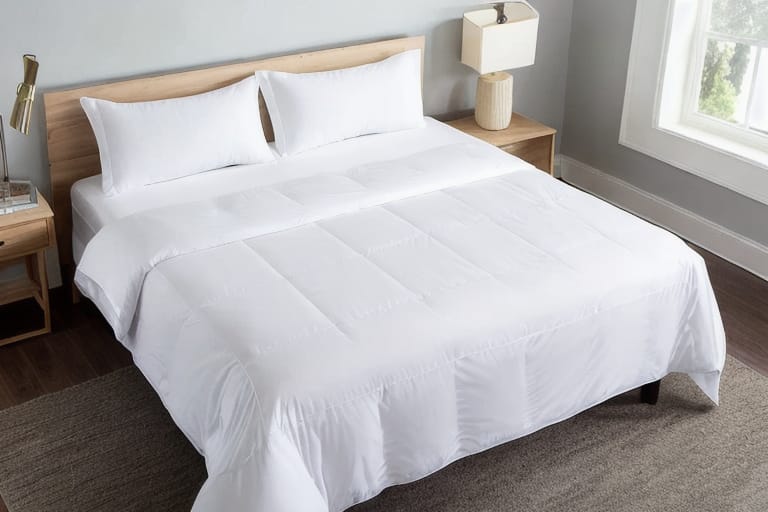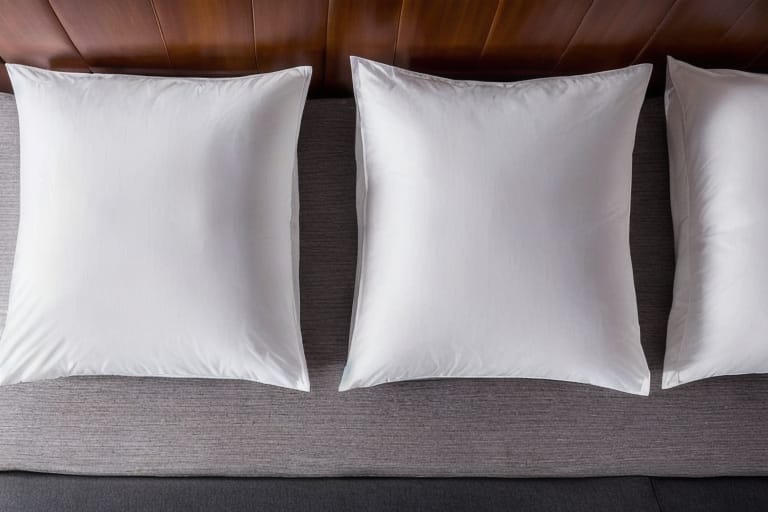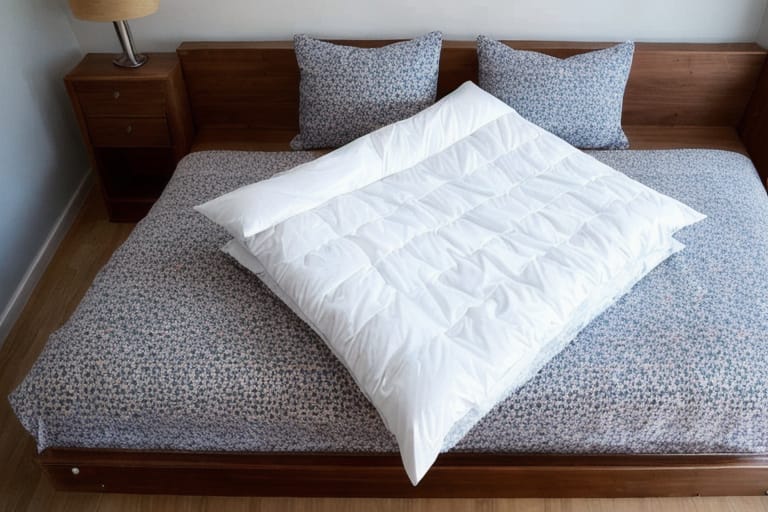Have you ever wondered why certain comforters are called “down comforters”? The name refers to the soft, insulating down filling inside made from duck or goose feathers. In this beginner’s guide, we’ll cover everything you need to know about down comforters, from the history of down to caring for your down-filled bedding. Read on to learn why this luxurious type of comforter earned the name it carries today.
A Brief History of Down Bedding
Down feathers from ducks and geese have been used as insulation and padding by humans for centuries. Ancient Europeans used to stuff pillows, comforters, and mattresses. However, large-scale commercial production of down bedding products is a relatively modern development.
The advent of lightweight, spacious, and affordable goose-down comforters took place in Europe during the late 18th century. At the time, eiderdown was very popular and prized as the ultimate filling for comforters. But true eiderdown, which comes from the nests of wild Eider ducks, was rare and expensive. Goosedown provided a more abundant and cheaper alternative.
Why Is It Called Down?
So why do we call it “down” in the first place? The term refers very specifically to the cluster of tiny, soft feathers closest to the body of ducks and geese. This includes both under-feathers and baby feathers that grow beneath the longer exterior feathers.
This ultra-soft plumage provides superior insulation while remaining incredibly lightweight. When used as a filling in comforters, the lofty down creates pockets of trapped air and maintains excellent warmth. It’s also exceptionally breathable, wicking moisture away from the body.
Over time, consumers began seeking out bedding products specifically filled with delicate “goose or duck down” for optimal comfort and warmth. And thus the iconic “down comforter” was born!
The Difference Between Down and Feathers
While both down and feathers come from ducks and geese, there are a few notable differences:
- Down – The soft under-feathers close to the duck or goose’s skin that provide insulation and loft
- Feathers – The longer exterior feathers that have a central quill and help birds fly
For the optimal balance of fluffiness, warmth, and durability, most down comforters contain a blend of both down and small feathers. The tiny feathers add just enough weight and structure to prevent shifting or clumping within the comforter shell.
Now that you understand the history behind the name, let’s look closer at the exceptional properties of Down and why it creates such an unparalleled sleeping experience.
The Unique Properties of Luxurious Down
Incomparable Insulation
Down comforters provide top-tier warmth for several reasons:
- The tiny feather clusters trap large volumes of air, maintaining body heat much better than other materials.
- The fluffy, three-dimensional structure leaves ample room for loft and breathability to avoid overheating.
- The soft feathers conform to your body’s outline, efficiently reducing heat loss.
This rare balance of lightness and insulation offered by down helps explain why it’s frequently referred to as “nature’s warmest insulator.”
Ultra-Pliable Cushioning
In addition to cloud-like softness, down supplies cushioning support:
- The fuzz-like feathers flexibly adapt to distribute your weight and alleviate pressure points.
- The filling gently conforms to your sleeping position but springs back into a thick, billowy shape.
- Down resists packing down even under compression, providing consistent comfort over time.
So while dense memory foam offers contouring support, breathable down delivers the perfect balance of softness and subtle structure.
Long-Lasting Durability
With proper care, a quality down comforter can last over 10 years! Thanks to the following characteristics:
- The tightly woven shell fabric protects the delicate interior fill.
- The generous fill volume allows for minor shifting and settling over time.
- Periodic cleaning revitalizes the loft and refreshes the down.
As long as you choose a sturdy construction and care for your comforter properly, you’ll enjoy years of cozy warmth!
Easy-Care Convenience
To clean lightweight pure down, most manufacturers recommend professional dry cleaning every year or two. However, there are a few easy at-home care tips to remember:
✔ Use a duvet cover to protect the shell fabric.
✔ Shake it outside regularly to redistribute and aerate.
✔ Spot clean stains quickly with mild soap and water.
✔ Dry clean every year or two depending on use.
✔ Store loose in a breathable bag or chest.
By caring for your comforter properly, you’ll keep it fluffy and clean for the long haul!
Now that you know why it’s called down and what sets it apart, let’s explore the key benefits…

5 Exceptional Benefits of Sleeping Under Down
Beyond just being feather-light yet remarkably warm, down comforters improve your shut-eye in other ways as well:
- Allergy Relief – Hypoallergenic varieties with special purification processes allow allergy sufferers to enjoy down.
- Luxurious Softness – Like sleeping on a fluffy cloud, down offers unbeatable plushness.
- Moisture Wicking – Quick-drying down whisks sweat away, keeping you comfortably dry.
- Easy Customization – Separate duvet covers allow for seasonal or decorative changes.
- Eco-Friendly Longevity – With proper maintenance, down comforters avoid waste by lasting over a decade!
From enhanced comfort to convenience to sustainability, high-end down truly offers the whole package.
Now let’s get down to business on what exactly distinguishes the finest down comforters available today…
What Makes the Best Down Comforters?
Fill Power
- Fill power indicates the loft and insulation.
- 600-fill and above is best, with 800-fill being exceptionally luxurious.
Fill Weight
- This specifies the ounces of down inside (not the total weight).
- For year-round use, a minimum of 20 oz is recommended.
Baffle Box Construction
- Small fabric boxes sewn inside keep the fill evenly distributed.
- Avoid cheaper “sewn-through” styles prone to shifting.
Thread Count and Fabric Weave
- Shell fabric should have a tight weave and high thread count
- 500 thread count in cotton, silk or microfiber ensures durability.
Checking these metrics when shopping will ensure you select a genuinely elite down-filled comforter built to last a lifetime.
Next, let’s dispel some common misconceptions…
Clearing Up Down Comforter Confusion
Despite their reputation for luxury, not all consumers fully understand what makes down comforters special. Here are some myths worth debunking:
Myth: All feather bedding will worsen allergies or asthma.
Fact: Hypoallergenic down comforters with special cleanings remove dust and dander.
Myth: Owning a down comforter means dry cleaning hassles and expenses. Fact: With a protective cover and proper home care, only periodic professional cleaning is needed.
Myth: Down comforters lose their fluff and insulating value quickly. Fact: Quality down maintains loft and lasts over a decade with basic maintenance.
Now that you know the truth about down, let’s cover caring for your investment…
5 Essential Tips for Down Comforter Care
Follow these best practices for keeping your comforter clean, fluffy and functional year after year:
- Use a duvet cover – Protects from body oils and spills
- Wash covers frequently – Every 1-2 weeks improves health
- Air out monthly – Restores loft and airflow
- Spot clean as needed – Use a delicate cycle with mild detergent
- Professionally clean every 2 years – Dramatically extend lifespan
If durability remains a concern, let’s examine some innovative advances making down even more reliable…
Down Innovation: The Latest in Cutting-Edge Comfort
While down itself remains nature’s ultimate insulation, leading manufacturers continually enhance other components of bedding:
Odor-Resistant Fabric Technology
Advances in textile chemistry and nano-materials provide durable yet breathable moisture protection:
- Polygiene anti-microbial prevents bacterial odors in the fabric
- Nanotex spill-resistance allows stain-free spot cleaning
Tencel Lyocell Shells
Made from fast-growing eucalyptus trees, lyocell fibers offer supreme durability:
- As strong as polyester but with a luxuriously soft cotton feel
- Perfect for those prone to night sweats thanks to unbeatable moisture control
Baffle Box Reinforcements
Improved baffle box stitching prevents fill shifting and maintains an even fill distribution across the entire comforter.
Thanks to enhancements like these, the current generation of down bedding delivers unprecedented reliability and longevity.
Navigating the range of options available today can remain confusing though…
Choosing Your Ideal Down Comforter by Sleep Style
Between differences in fill power, weight, and shell materials, finding your perfect match depends greatly on your sleeping habits and preferences:
Hot Sleepers
If you love luxurious softness but sleep hot, choose breathable layers with moisture control:
- Lower fill powers around 600 to limit insulation
- Lightweight fill weights less than 20 oz
- Moisture-wicking Tencel shells
Cold Sleepers
For those seeking serious warmth from plush down:
- Higher fill power numbers near 800+
- Heavier fill weights from 20-35 oz
- Cozier microfiber shell for added insulation
Allergy Sufferers
Look for advanced purification processing and protective encasings:
- UltraClean certification by the IDFL ensures maximum cleanliness
- Cotton shells naturally deter dust mites
- Cover encasings add an allergen barrier for severe sensitivities
No matter your sleep needs, an ideal down comforter awaits! Let’s wrap things up…

The Final Word on Down Bedding Luxury
We’ve covered a lot of ground exploring why these plush bedding essentials are called down comforters – and why they deliver an unmatched restful slumber!
To recap, genuine down comforters:
- Originated from the unbeatable insulation of fine duck and goose down feathers
- Provide cloud-like softness, cushioning support, and moisture control
- Are conveniently customizable and engineered for environmental friendliness
- Retain loft and last over a decade with easy at-home maintenance
While alternatives like synthetic fills exist, none replicate the sublime lightweight warmth of luxurious down bedding. By selecting the proper fill power, weight, and shell for your needs, these comforters can be enjoyed by sleepers of all types.
Frequently Asked Questions
What exactly is down and distinguishes it from other feathers?
As we learned earlier, down refers specifically to the soft under-feathers closest to the bodies of ducks and geese that provide exceptional insulation. This includes delicate under-feathers and baby plumage lacking rigid quills. True down clusters offer superior breathability, loft and lightweight warmth compared to exterior feathers.
How do I know if a comforter actually contains high-quality down?
Check for certifications from the International Down and Feather Testing Laboratory (IDFL) which tests “fill power” through specialized equipment. Reputable brands with European down will advertise their products fill power, typically 600 and above for excellent performance and 800+ for luxury quality down.
What’s the best way to care for my down comforter at home?
Always protect the shell fabric with a tightly woven, high thread count cover and wash it regularly. For professional cleaning every year or two, ask if they utilize advanced techniques like ultraviolet-light sanitization to maximize hypoallergenic properties without damaging the loft. In between, gently shake and air out the comforter outside every 3-6 months.
How long can I expect a quality down comforter to last with regular use?
Thanks to advances in down sourcing and processing like the UltraClean standard, as well as reinforced “baffle box” construction, you can enjoy a well-made down comforter for 10-15 years. Focus on preventative care like duvet covers rather than intensive washing. With periodic refreshing and reshaping of the fill, your investment will pay dividends in nightly comfort.
What would make a hot sleeper still want to consider using a down-filled comforter?
Even if you run warm, a lightweight summer down comforter allows you to enjoy features like cloud-like plushness and breathability. Search for options with lower fill ratings of around 600 fill power. This provides just enough insulation for cooler nights but avoids overheating issues. Adding a cooling percale cotton shell and avoiding thicker microfiber outer fabric also caters perfectly to warm sleepers.








